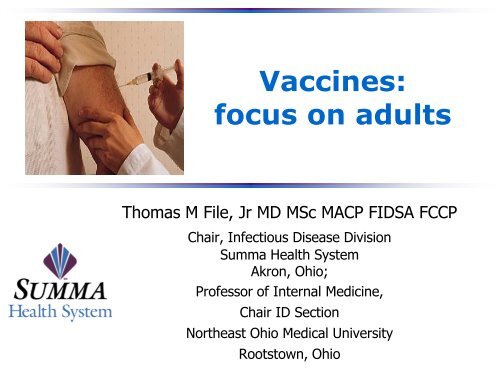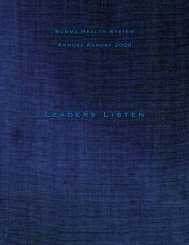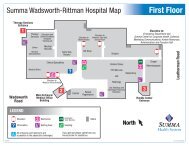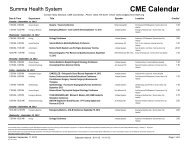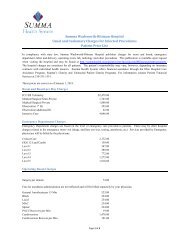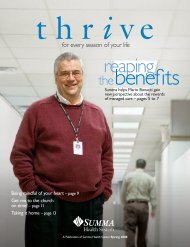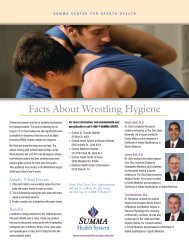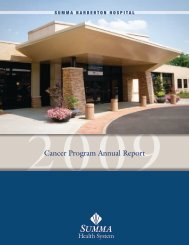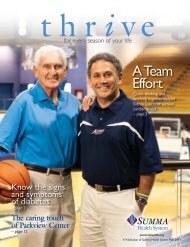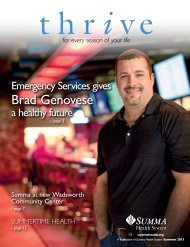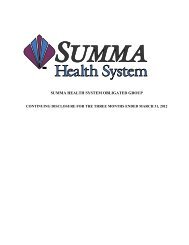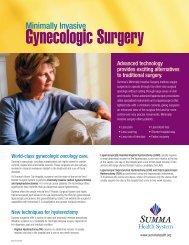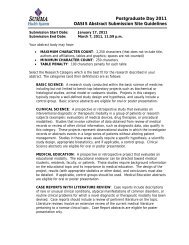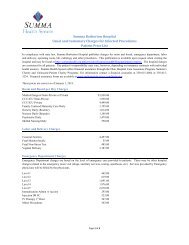Vaccines: focus on adults - Summa Health System
Vaccines: focus on adults - Summa Health System
Vaccines: focus on adults - Summa Health System
You also want an ePaper? Increase the reach of your titles
YUMPU automatically turns print PDFs into web optimized ePapers that Google loves.
<str<strong>on</strong>g>Vaccines</str<strong>on</strong>g>:<str<strong>on</strong>g>focus</str<strong>on</strong>g> <strong>on</strong> <strong>adults</strong>Thomas M File, Jr MD MSc MACP FIDSA FCCPChair, Infectious Disease Divisi<strong>on</strong><strong>Summa</strong> <strong>Health</strong> <strong>System</strong>Akr<strong>on</strong>, Ohio;Professor of Internal Medicine,Chair ID Secti<strong>on</strong>Northeast Ohio Medical UniversityRootstown, Ohio
Impact of <str<strong>on</strong>g>Vaccines</str<strong>on</strong>g>• <str<strong>on</strong>g>Vaccines</str<strong>on</strong>g> are <strong>on</strong>e of the mostimportant tools we have to protect thehealth of our nati<strong>on</strong>'s most vulnerablecitizens, our children. (also <strong>adults</strong>,especially older <strong>adults</strong>)• In last 100 years life span of Americanshas doubled; largely as a result ofvaccines and sanitati<strong>on</strong>GA Poland 2011
Ten Great Public <strong>Health</strong>Achievements-US1900-1999• Vaccinati<strong>on</strong>• Motor-vehicle safety• Safer workplaces• C<strong>on</strong>trol of infectious diseases• Decline in deaths from cor<strong>on</strong>ary heart diseaseand stroke• Safer and healthier foods• <strong>Health</strong>ier mothers and babies• Family planning• Fluoridati<strong>on</strong> of drinking water• Recogniti<strong>on</strong> of tobacco use as health hazard
Threats to <str<strong>on</strong>g>Vaccines</str<strong>on</strong>g>• Falling rates• Success of past vaccines• Lack of awareness of diseasethat is prevented• Effects of anti-vacccinemovement• Fear, mistrust, ignoranceGA Poland 2011
U.S. Measles Outbreak Sees Cases At15-Year High•Most associated with travel to or travels from France•France > 10,000 cases 2011 (several deaths) as a result ofdecrease in immunizati<strong>on</strong>•Increased cases in US (Case at SuperBowl 2012!!!)
Pertussis Outbreaks•California (2010)9,143 cases of pertussis (including ten infant deaths) were reportedthroughout California. This is the most cases reported in 63 years. In2011, disease activity is still at relatively increased levels throughout thestate. Visit the California Department of Public <strong>Health</strong> website for themost recent informati<strong>on</strong>.•Ohio (2010-2011)•In Ohio, Columbus Public <strong>Health</strong> (CPH) and Franklin County Board of<strong>Health</strong> (FCBH) resp<strong>on</strong>ded to an outbreak of pertussis during 2010 and2011. In 2010, there were 964 cases reported by Columbus and FranklinCounties. This is the most cases reported in 25 years. Through April 9,2011, 144 cases of pertussis were reported. For the most recentinformati<strong>on</strong>, visit the Columbus Public <strong>Health</strong> web site.
VACCINE PREVENTABLE DEATHSFOR ADULTS IN US• Adults--50,00-70,000(estimated) annually• Most comm<strong>on</strong> “preventable” deaths:• Influenza (20-40,000/yr in US)• S. pneum<strong>on</strong>iae• Hepatitis B (Cirrhosis, Liver Cancer)• Human Papilloma Virus (Cervical Cancer)• Cost of hospitalizati<strong>on</strong> due to vaccinepreventablediseases > $30 billi<strong>on</strong>/year
Burden of Vaccine-Adult PreventableDisease in the United StatesDiseaseInfluenzaInvasivepneumococcaldiseaseHepatitis BHumanpapillomavirusPertussisZosterAnnual Burden of Disease, United States200,000 hospitalizati<strong>on</strong>s; 36,000 deaths (> 90% in older<strong>adults</strong>)44,000 cases, 4500 deaths (higher rates of both in older<strong>adults</strong> and pers<strong>on</strong>s with comorbidities)51,000 infecti<strong>on</strong>s (95% <strong>adults</strong>); 2000-3000 deaths;1.25 milli<strong>on</strong> with chr<strong>on</strong>ic HBV infecti<strong>on</strong>6.2 milli<strong>on</strong> new infecti<strong>on</strong>s (>4000 women die in USannually; ? Male deaths)10,454 cases reported in 2007 (3152 <strong>adults</strong>)Severe illness in infants; often transmitted by older child oradult1 milli<strong>on</strong> cases; risk for shingles and postherpetic neuralgiaincreases with age
ADULT VACCINES• PneumococcalInactive• InfluenzaInactive/Live• SmallpoxLive• Hepatitis A and BInactive• Tetanus, diptheriaInactive(toxoid)• VaricellaLive• MeningococcalInactive• RabiesInactive• Measles, Mumps, Rubella Live• Polio(2 types)Inactive/Live• Human Papilloma Virus Inactive• ZosterLive• Acellular Pertussis (for <strong>adults</strong>) Inactive• Human papilloma virus Inactive
Adult vaccines Too Low
Why Adults are not vaccinated
Physician-PatientMiscommunicati<strong>on</strong>
Who influences <strong>adults</strong> decisi<strong>on</strong>sto get immunized?Pers<strong>on</strong>al Physicians can overcome negative attitudes of patients!!
The Communicati<strong>on</strong>s BreakdownRecommendati<strong>on</strong>“Youneed toget thisvaccine.”OR“I wantyou toget thisvaccine.”Vaccine-MotivatedPatientNot a Recommendati<strong>on</strong>“Do youwant thisvaccine?”OR“Thinkaboutgetting thevaccine.”Vaccine-AmbivalentPatient
Is it for fear of needles?Not for most
Need to improve Vaccine Uptake• Clear and unambiguous messageto public, patients, providers• High benefit/risk ratio• SAFE• Low rates lead to outbreaks anddeath• Anti-vaccine movement isharmful to public healthGA Poland 2011
Before vaccines, milli<strong>on</strong>s died of Measles,Polio, or Smallpox
<str<strong>on</strong>g>Vaccines</str<strong>on</strong>g>: Very highbenefit/risk ratio• All vaccines have possible sideeffects, most mild, rarely severe• The risk of disease far outweighsthe risk of vaccine• MESSAGE:• <str<strong>on</strong>g>Vaccines</str<strong>on</strong>g> Effective• Safe• Need to recommend
Institute of Medicine Report-August 2011• <str<strong>on</strong>g>Vaccines</str<strong>on</strong>g> offer the promise of protecti<strong>on</strong>against a variety of infectious diseases.Despite much media attenti<strong>on</strong> and str<strong>on</strong>gopini<strong>on</strong>s from many quarters, vaccinesremain <strong>on</strong>e of the greatest tools in thepublic health arsenal. Certainly, somevaccines result in adverse effects thatmust be acknowledged. But the latestevidence shows that few adverse effectsare caused by the vaccines reviewed inthis report.
Adult Vaccinati<strong>on</strong>: 3 patients1. 40-year-old woman from Mexico who has a history ofasthma, otherwise healthy. She has come to your officefor a health screen for a school cafeteria job2. 65-year-old male has come to your office for a physicalexaminati<strong>on</strong>. He has no medical records, and reports thathe has smoked for many years. Initial evaluati<strong>on</strong> revealsmild emphysema and diabetes.3. 30-year-old pregnant woman with 2 young children. It isthe start of the school year, and Corrine reports neverhaving received a seas<strong>on</strong>al influenza vaccine.• Which <str<strong>on</strong>g>Vaccines</str<strong>on</strong>g>: Influenza, Tdap, zoster, MMRpneumococcal, Meningococcal
ACIP Adult Immunizati<strong>on</strong> Schedulehttp://www.cdc.gov/vaccines/recs/schedules/downloads/adult/adult-schedule.pdf
Influenza vaccine: BenefitBased <strong>on</strong> risk-benefit c<strong>on</strong>siderati<strong>on</strong>s, therecepti<strong>on</strong> of and the administrati<strong>on</strong> ofinfluenza vaccines are arguably themost beneficial health promotinginterventi<strong>on</strong>s available to us and ourpatients. Influenza vaccines preventillness and death and are safeALL PERSONS > 6 MONTHS OF AGESHOULD RECEIVE YEARLYINFLUENZA VACCINEEspecially pregnancy
INFLUENZA VACCINE-Importance• Influenza may lead to many complicati<strong>on</strong>s in <strong>adults</strong>• sec<strong>on</strong>dary pneum<strong>on</strong>ia• exacerbati<strong>on</strong> of underlying disease(i.e., chr<strong>on</strong>ic lung or heartdisease)• Influenza virus changes antigens over time; patients maytherefore, not be immune because of prior exposure• Efficacy• Prevents illness in approx 70-90% of pers<strong>on</strong>s < 65 years• 30-70% effective in preventing hospitalizati<strong>on</strong> in elderly• Can be given at SAME time as pneumococcal vaccine
US Influenza <str<strong>on</strong>g>Vaccines</str<strong>on</strong>g>• TIV: ‘Killed’, injectable “All comers” 6 m<strong>on</strong>ths and older• TIV Intradermal• Approved May 2011 for 18-64 years [smaller needle]• LAIV: Live-attenuated, cold-adapted nasal (CANNOT replicate at bodytemperature)-nasal spray• very minimal viral shedding; OK to give to nurses unless taking care ofseverely immunocompromised patients (e.g. Stem cell transplant)• Indicated <strong>on</strong>ly for healthy people 2-50 years• High-Dose TIV for 65+ populati<strong>on</strong> * [first available 2010-11]• Same producti<strong>on</strong> process as TIV; higher Ag dose• Seroc<strong>on</strong>versi<strong>on</strong>, seroprotecti<strong>on</strong> rates ≥ TIV for A, B strains• Superiority criteria for A, N<strong>on</strong>-inferiority for B strain• Local reacti<strong>on</strong>s more frequent but classified as mild• ‘Real world’ efficacy data not published to dateTIV, trivalent inactivated vaccine*Falsey AR et.al. J Infect Dis. 2009;200:172-180.
INFLUENZA VACCINEHigh Dose• Fluz<strong>on</strong>e High-Dose• C<strong>on</strong>tains 60 mcg each of the 3 Influenzaantigens (compared to 15 each for regular TIV)• Rati<strong>on</strong>al: results in higher AB levels in elderly patients;unknown if this will result in better protecti<strong>on</strong> but indirectevidence is suggestive• Slightly higher rate of MILD reacti<strong>on</strong>s• Indicati<strong>on</strong>s: Patients > 65 years.• Costs
INFLUENZA VACCINEReducti<strong>on</strong> in Hospitalizati<strong>on</strong>s for Cardiac disease andStrokes (Nichols et a. NEJM 348, April 3, 2003)• Observati<strong>on</strong>al studies of large cohorts (140,000;146,000), ’98-’99 AND ’99-’00, 3 HMOs, age 65• Vaccinati<strong>on</strong> against influenza associated withreducti<strong>on</strong> in hospitalizati<strong>on</strong> for :• Cardiac disease (19% both seas<strong>on</strong>s)• Cerebrovascular disease (16%; 23%)• Pneum<strong>on</strong>ia and Influenza (32%; 29%)• All cause Death (48%; 50%)• Possible mechanisms: infect cause alterati<strong>on</strong>s inclotting factors, platelet aggregati<strong>on</strong>, amount ofinflammatory- resp<strong>on</strong>se cytokines which enhancethrombosis
Influenza ‘Nuts and Bolts’ 1• Vaccinati<strong>on</strong> seas<strong>on</strong>: So<strong>on</strong> as available to ~April 1• <str<strong>on</strong>g>Vaccines</str<strong>on</strong>g> approved by FDA for 6 manufacturers; June 2011- shipping• Late seas<strong>on</strong> vaccinati<strong>on</strong> important and underutilized• Most disease in mid-south in January-March• LAIV , TIV, HD-TIV: 1 dose for <strong>adults</strong>• Kids
Adverse effects• Local reacti<strong>on</strong>s: soreness at vaccinati<strong>on</strong> site• Mild, rarely interfered with ability to c<strong>on</strong>duct usualactivities• In placebo-c<strong>on</strong>trolled trials no associati<strong>on</strong>with higher rates for systemic symptoms• Fever, malaise, myalgia, headache• CANNOT get influenza from trivalentinactivated vaccine (TIV)• Rare AEsMorbidity and Mortality Weekly Report. 2009; 58: 1-52
Adverse effects: rare or notassociated• Immediate hypersensitivity: 1 per 500,000• GBS:• IN general populati<strong>on</strong> annual incidence 10-20/milli<strong>on</strong>• Except for possibly associated with 1976 vaccine, nocompelling evidence of associati<strong>on</strong> with influenza vaccine(including 2009 H1N1)• Ocularespiratory Syndrome• In <strong>on</strong>e placebo-c<strong>on</strong>trolled trial, 2%• Red eyes, cough, wheezing, chest tightness within 2-24hours; resolve within 24 hours; If no evidence ofhypersensitivity can receive subsequent TIV• AUTISM: Absolutely NO ASSOCIATION!!!!!Morbidity and Mortality Weekly Report. 2009; 58: 1-52
Influenza and Pregnancy• Pregnant woman at high risk forsevere complicati<strong>on</strong>s and death• Cellular immune resp<strong>on</strong>se diminished• Maternal influenza associated withincreased (Zaman et al. NEJM 2008)• Maternal hospitalizati<strong>on</strong>• Fetal malformati<strong>on</strong>• Other illnesses• Preventi<strong>on</strong> is best approach• Newborns are at high risk forsevere complicati<strong>on</strong>s• Several reports of 2 nd MRSA infecti<strong>on</strong>• No approved vaccine for infants < 6 m<strong>on</strong>thsof age• All care givers need to be free from possibletransmissi<strong>on</strong> to this vulnerable populati<strong>on</strong>
Benefits/Obligati<strong>on</strong>s of Influenza vaccinefor <strong>Health</strong>care providers• As HCW we all have an obligati<strong>on</strong> to protect ourpatients• Transmissi<strong>on</strong> may occur without illness• May be asymptomatic carriers• Infectious prior to <strong>on</strong>set of symptoms• Studies show reduced transmissi<strong>on</strong> after vaccinati<strong>on</strong>• Protecti<strong>on</strong> form acute illness• For H1N1 greatest morbidity and mortality is in ‘healthy’individuals aged 20-50.• Protecti<strong>on</strong> of family members (especially if veryyoung or with medical c<strong>on</strong>diti<strong>on</strong>s)• Mandatory immunizati<strong>on</strong> of all HCW being proposed
Centers for Disease C<strong>on</strong>trol and Preventi<strong>on</strong>. 2010. Active Bacterial Core Surveillance Report, EmergingInfecti<strong>on</strong>s Program Network, Streptococcus pneum<strong>on</strong>iae, 2009. http://www.cdc.gov/abcs/reportsfindings/survreports/spneu09.pdf.Accessed February 3, 2011.Pneumococcal Diseases causes more deaths peryear in US than Breast Cancer or Prostate CancerXu. Et al. Deaths: Prelimanary data for 2007. Natl Vital Stat Rep. 2009; 58: 1-51
Pneumococcal <str<strong>on</strong>g>Vaccines</str<strong>on</strong>g>-<strong>adults</strong>• 90 known serotypes of S. pneum<strong>on</strong>iae• Pneumococcal polysaccharide vaccine (PPSV23)• Inactive vaccine; c<strong>on</strong>tains 23 serotypes which account for majority (75-80%)of clinical disease.• Approved for use in <strong>adults</strong> of any age; ? Efficacy for pneum<strong>on</strong>ia• CDC recommends PPSV23 for <strong>adults</strong> age 65 years and older ;and younger<strong>adults</strong> with risk factors• Pneumococcal c<strong>on</strong>jugate vaccine (PCV13) approved for use in<strong>adults</strong> age 50 and older• Inactive vaccine, c<strong>on</strong>jugated with diptheria CRM 197 protein); 13 serotypeswhich account for approx 45-50% of invasive disease• Approval from FDA announced December 30, 2011 for <strong>adults</strong> 50 years andolder• Previously approved and recommended for use in children• CDC’s Advisory Committee <strong>on</strong> Immunizati<strong>on</strong> Practices (ACIP) recommendsuse for patients who are immunocompromised
PNEUMOCOCCAL VACCINEPolysaccharide (PPV23) C<strong>on</strong>jugate (PCV13)# serotypes 23 13Protein carrier No YesInducti<strong>on</strong> B memory cellsand amnestic resp<strong>on</strong>se No YesReducti<strong>on</strong> of carriageof vaccine types No YesApproved for <strong>adults</strong> Yes YESApproved for pediatrics No Yes
PNEUMOCOCCAL VACCINEPolysaccharide VaccineVACCINE CHARACTERISTICS• Efficacy: Reduces invasive(bacteremia)disease by 50-81% in <strong>adults</strong>• Most studies show it DOES NOT reduce incidence ofpneum<strong>on</strong>ia in <strong>adults</strong> but DOES reduce InvasivePneumococcal Disease (bacteremia, meningitis, mortality)due to pneum<strong>on</strong>ia• NOT effective for children < 2 years of age• Does not reduce ‘col<strong>on</strong>izati<strong>on</strong>’• C<strong>on</strong>tains the antigens from the 6 serotypes most oftenassociated with penicillin resistance• Eventual declining immunity after first dose(may requireredosing)File TM, et al. Infect Dis Clin Pract. 2012;20:3-9.
Indicati<strong>on</strong>s for 23-valent PneumococcalPolysaccharide Vaccine• All <strong>adults</strong> 65 years of age and older• Age 19 - 64 years who has a l<strong>on</strong>g term health problemsuch as:• heart dis, lung dis, sickle cell dis, diabetes, alcoholism, cirrhosis,leaks of cerebrospinal fluid or cochlear implant• Age 19- 64 years who has c<strong>on</strong>diti<strong>on</strong> that lowersresistance to infecti<strong>on</strong> (immunocompromised), such as:• Hodgkin’s disease, lymphoma or leukemia, kidney failure,myeloma, nephrotic syndrome, HIV/AIDS, hyposplenism, organtransplant, steroids, certain cancer drugs• Any adult 19 through 64 years of age who:• is a smoker• has asthmaCDC: Advisory Comm <strong>on</strong> Immunizati<strong>on</strong> Practices
Clin Infect Dis. 2008; 46: 1015-23
From Medscape Infectious Diseases > Expert CommentaryPneumococcal Immunizati<strong>on</strong> Strategies for AdultsThomas M. File, Jr., MDPosted: 12/17/2010• Should PCV or PPV be c<strong>on</strong>sidered for those approaching theage of indicati<strong>on</strong> (65 years) who do not have comorbidc<strong>on</strong>diti<strong>on</strong>s?• I am pers<strong>on</strong>ally interested because I, too, will so<strong>on</strong> reach theage of indicati<strong>on</strong>. Would it be better for me to receive PCV13 orPPV23 as my initial pneumococcal vaccine? We can <strong>on</strong>ly rely<strong>on</strong> the immunogenicity studies and a few studies performed inspecial populati<strong>on</strong>s (such as HIV-infected individuals). It ispossible that an initial dose of PCV13 followed by PPV23 (toenhance the number of serotypes covered) may provide betterimmunity and, more important, better effectiveness in diseasereducti<strong>on</strong>. For this reas<strong>on</strong>, I am leaning toward this strategyrather than the use of PPV23 followed by PCV13.
Recommendati<strong>on</strong>s for PCV13 and PPSV23for immunocompromised <strong>adults</strong>** Advisory Comm Immunizati<strong>on</strong> Practices, ACIP, CDC
PCV13 Recommended forImmunocompromised Patients
PNEUMOCOCCAL VACCINE13 valent c<strong>on</strong>jugated vaccine study for <strong>adults</strong>CAPITA Study (Community Acquired Pneum<strong>on</strong>iaImmunizati<strong>on</strong> Trial in Adults)• RCT trial in Netherlands• Design• 13 valent c<strong>on</strong>jugate vaccine (same as pediatricvaccine)• Placebo c<strong>on</strong>trolled (1:1); approx 85,000 subjects,> 65 years of age, community dwelling• Endpoints:• Primary-preventi<strong>on</strong> of CAP (serotype specific)• Sec<strong>on</strong>dary-all cause CAP, col<strong>on</strong>izati<strong>on</strong> (2000subjects), mortality, bacteremiaHak et al. Netherlands J Med. 2008; 66: 378-381
Polysaccharide VACCINERevaccinati<strong>on</strong>• A 35 y/o immunocompetent male is a smoker andreceives pneumococcal vaccine. When should hereceive revaccinati<strong>on</strong>?• A 35 y/o male with HIV receives pneumococcalvaccine. When should he receive revaccinati<strong>on</strong>?• A 65 y/o male receives pneumococcal vaccine. Whenshould he receive revaccinati<strong>on</strong>?OPTIONS:A. In 5 yearsB. Age 65C. No revaccinati<strong>on</strong> indicated
polysaccharide VACCINERevaccinati<strong>on</strong>• Revaccinati<strong>on</strong> per CDC recommendati<strong>on</strong>s• Immunocompetent but with underlying medicalc<strong>on</strong>diti<strong>on</strong> (e.g., : If > 5 years since 1 stAdministrati<strong>on</strong>; and aged < 65 at time of 1stAdministrati<strong>on</strong>; and now > 65 years of ageor• One-time revaccinati<strong>on</strong> after 5 years forpers<strong>on</strong>s with significant underlying c<strong>on</strong>diti<strong>on</strong>s(i.e., chr<strong>on</strong>ic renal failure, HIV, leukemia,lymphoma, myeloma, Hodgkins, l<strong>on</strong>g-termsteroids)
Pertussis Vaccine: Adults• DTaP (Pediatric vaccine)• Daptacel, Infanrix, Tripedia• C<strong>on</strong>tains higher c<strong>on</strong>centrati<strong>on</strong> of diptheria toxoid and acellularpertussis• Tdap = Tetanus and Diptheria Toxoid, and AcellularPertussis• Adacel (Sanofi Pasteur); Boostrix (GSK)• Single dose for pers<strong>on</strong>s 11-18 years of age who have completed thechildhood series• Single dose for <strong>adults</strong> aged 19 years and older (Including <strong>adults</strong> 65+[esp. those with infant c<strong>on</strong>tact)• Tdap should be administered regardless of interval since the lasttetanus-c<strong>on</strong>taining vaccine, especially if the patient will have c<strong>on</strong>tactwith children
ACIP Recommendati<strong>on</strong>s: Tdap Vaccine• Single dose for children 7 to 10 years of age andwho are not fully vaccinated against pertussis.• Single dose for pers<strong>on</strong>s 11-18 years of age whohave completed the childhood series.• Single dose for <strong>adults</strong> aged 19 years and older.• Including <strong>adults</strong> 65+ [esp. those with infant c<strong>on</strong>tact]• Tdap should be administered regardless ofinterval since the last tetanus-c<strong>on</strong>tainingvaccine, especially if the patient will havec<strong>on</strong>tact with children
ACIP Tdap Recommendati<strong>on</strong>sSpecific Priority Groups• Pregnant women at more than 20 weeks'gestati<strong>on</strong>• Adults, regardless of age, who are inclose c<strong>on</strong>tact with infants younger thanage 12 m<strong>on</strong>ths (e.g., parents,grandparents, or child-care providers)• <strong>Health</strong>care Providers
Herpes Zoster(Shingles)• Approx 1 milli<strong>on</strong> cases of herpes zoster annually inUS; 50% in those >60 years; pain can be severe.• Complicati<strong>on</strong>s: postherpetic neuralgia; eye, visceral,nerve palsies; sec<strong>on</strong>dary bacterial infecti<strong>on</strong>Photographs courtesy of Thomas M. File, Jr, MD
Zoster Vaccine (Zostavax )• Live vaccine• Approved for the preventi<strong>on</strong> of herpes zoster(shingles) in pers<strong>on</strong>s aged 50 years andolder.• In 38,000 patient study, reduced the incidence ofshingles by 51% in pers<strong>on</strong>s aged 60 years andolder (less effective in older patients)• Incidence of postherpetic neuralgia less by 39%.
Zoster Vaccine (Zostavax )• Single SC injecti<strong>on</strong> within 30 minutes ofrec<strong>on</strong>stituti<strong>on</strong>.• Does not require documentati<strong>on</strong> of priorvaricella to give• Proper time after zoster is c<strong>on</strong>troversial.Expert recommendati<strong>on</strong>s vary from 6 m<strong>on</strong>thsto 2 yrs.• C<strong>on</strong>traindicati<strong>on</strong>s• Allergy to gelatin, neomycin• Immunodeficiency (administer preferably 4 wks prior toimmunosuppressive therapy, can give if in remissi<strong>on</strong> fromleukemia or lymphoma for 3 m<strong>on</strong>ths; low dose steroids, < 20 mg/d for < 14 days, is OK)• Active TB• Pregnancy
Human Papillomavirus (HPV) Vaccine:first cervical cancer vaccine• Impact of HPV• Cervical and Vaginal HPV are the most comm<strong>on</strong>sexually transmitted disease• Estimated 6.2 milli<strong>on</strong> women and men infectedin US annually• 74% in ages 15-24; Lifetime risk = 50%• Infecti<strong>on</strong> with <strong>on</strong>cogenic HPV types (especially 16and 18) is most significant risk factor fordeveloping cervical cancer• Approx 4000 women die annually• <str<strong>on</strong>g>Vaccines</str<strong>on</strong>g> reduces Cervical intraepithelialneoplasia (CIN) > 90%
Human Papillomavirus (HPV) Vaccine• HPV vaccine significantly reduces HPV infecti<strong>on</strong> andsubsequent cancer changes (cervical and anal);• Inactive vaccine; 3 injecti<strong>on</strong>s over 6 m<strong>on</strong>ths• Quadrivalent (Gardisil 6,11,16,18) and Bivalent(Cervarix 16,18); Approved for females ages 9-26• Routine vaccinati<strong>on</strong> against HPV is recommended for allgirls 11-12 years of age. Can be started in age 9• “Catch-up” vaccinati<strong>on</strong> recommended for females 13-26 years.• ACIP recommends all 11-12 year-old males getvaccinated against HPV (October 25, 2011): protectsagainst 90% warts
COMBINED HEPATITIS A andHEPATITIS B VACCINE• Twinrix®• C<strong>on</strong>tains inactive heptitis A virus and recombinanthepatitis B surface antigen• Indicati<strong>on</strong>s• Chr<strong>on</strong>ic liver disease; Illicit drug user; Men who have sexwith men; Recipients of therapeutic blood products;Travelers to areas of endemicity• Primary vaccinati<strong>on</strong>: 3 does (0.1.6-m<strong>on</strong>th schedule)• Accelerated Dosing: A series of 4 doses (1mL each) given <strong>on</strong> days 0, 7, and 21 to 30followed by a booster dose at m<strong>on</strong>th 12.
MENINGOCOCCAL VACCINE• Vaccine characteristics• Inactive vaccine• Polysaccharide Quadrivalent-serogroupsA, C, Y, W-135• Quadrivalent C<strong>on</strong>jugate vaccine (Menactra)• Same serogroups; approved for ages 2-54• Better and L<strong>on</strong>ger immunity• Indicati<strong>on</strong>s(somewhat c<strong>on</strong>troversial)• College freshman(recommended by Am Coll of <strong>Health</strong>Assoc; not yet routinely recommended by CDC)• NOW Recommended by CDC with booster dose oftetravalent meningococcal vaccine should be routinelyadministered to adolescents 5 years after the first doseis given at ages 11 through 13 years (ACIP Oct 28,2010)• Travelers to high risk areas
HEPATITIS B VACCINE• New Recommendati<strong>on</strong> by Advisory Committee<strong>on</strong> Immunizati<strong>on</strong> Practices (Nov 2011)• Hepatitis B vaccine recommended now for all patientswith diabetes ages < 60 years• Reflects new informati<strong>on</strong> that <strong>adults</strong> with diabetes < 60years of age are twice as likely to get hepatitis B andmay experience greater morbidity and mortality.• Some feedback:• WHY NOT UNIVERSAL (including age >60)
Adult vaccines: Retail cost• Pneumocovax-approx $60• Prevnar 13-approx $120• Gardasil – for the series of 3 shots - $429.20• Zostavax – for <strong>on</strong>e shot - $185.15• Adacel – for <strong>on</strong>e shot - $46.76• Recombivax HB – for series of 3 shots - $198.09• Havrix – for series of 2 shots - $107.18
The wars of the world: Saving livesthrough vaccinati<strong>on</strong>DW Kimberlin Inf Dis News. Aug 1, 2011• It’s been a hard week. The infectious diseases ward of our hospital isso full that we have to put many children who normally would be inisolati<strong>on</strong> wings <strong>on</strong> regular floors. The 3-year-old with smallpox diedearly this morning, and the three infants <strong>on</strong> the ventilator withmeasles pneum<strong>on</strong>ia are not far behind.• Although there is not much more to do for them, the house staff isc<strong>on</strong>sistently over their duty hours because of the sheer number ofother children in the hospital. The easiest way to tell the dozenchildren with bacterial meningitis apart is that the eight withHaemophilus influenza type b meningitis have seizures that areeasier to c<strong>on</strong>trol than the two with pneumococcal central nervoussystem infecti<strong>on</strong>. Of course, the two with meningococcus are easilydistinguished by their amputati<strong>on</strong>s. The <strong>on</strong>e bit of good news is thatit is not summertime, so at least we do not have to deal with polioyet. You’d think that in the year 2011 something could be d<strong>on</strong>e toprevent this.
The wars of the world: Saving livesthrough vaccinati<strong>on</strong>DW Kimberlin Inf Dis News. Aug 1, 2011• Without the safe and effective vaccines that wetoo often take for granted now, more than 300milli<strong>on</strong> who lived full and rewarding lives duringthe 20th century would have died prematurelyof a vaccine-preventable disease. Compare thiswith the 160 milli<strong>on</strong> estimated to have beenkilled in all wars combined during the samecentury. Stated another way, vaccines savedtwice as many lives as were lost in war duringthe most destructive 100 years in humanhistory.
The wars of the world: Saving livesthrough vaccinati<strong>on</strong>DW Kimberlin Inf Dis News. Aug 1, 2011• With this as background, it is incredible to me that any<strong>on</strong>e woulddeliberately refuse the protecti<strong>on</strong>s that previous generati<strong>on</strong>s wouldhave given their eye teeth to have had. I am certain that today’svaccine refusers love their children just as much as parents did in prioreras. So why would so many people willingly leave their children at realrisk for lifel<strong>on</strong>g disability or death when there is a way to prevent it?• I believe that in most situati<strong>on</strong>s, it comes down to a mispercepti<strong>on</strong> ofwhat the risks really are, and this mispercepti<strong>on</strong> is aggravated by the<strong>on</strong>slaught of (mis)informati<strong>on</strong> that is available at the click of a mouse.• Measles vaccine does not cause autism, nor does it produceinflammatory bowel disease. In 2011, though, measles virus has killed12 children in France and left six with permanent brain damage. Is itmore dangerous to have your child vaccinated against measles or totake him to France for a w<strong>on</strong>derful family vacati<strong>on</strong>?
Vaccine Messages• Clear and unambiguous• <str<strong>on</strong>g>Vaccines</str<strong>on</strong>g> have highbenefit/risk ratio• SAFE• Anti-vaccine groups harmfulto public healthGA Poland 2011
Supplemental Slides
Which vaccines are appropriate forElena (40 y/o woman)?Tetanus, diphtheria, and acellular pertussis (Tdap);influenza; and pneumococcal vaccines areappropriate for Elena. Because she does not recallreceiving the 3-dose primary vaccinati<strong>on</strong> series with Tdc<strong>on</strong>tainingvaccine, Elena should begin the series of 1 dose ofTdap and 2 doses of Td. She should also receive the annualinfluenza vaccine. (Because of her asthma, Elena shouldreceive the trivalent inactivated vaccine [TIV] rather than thelive attenuated influenza vaccine [LAIV].) Elena's asthma isan indicati<strong>on</strong> for her to receive pneumococcal vaccine.
Which vaccines are appropriate forArthur (65 y/o male?Arthur's age (65 years), emphysema, and diabetesare indicati<strong>on</strong>s for 4 vaccines. Influenza,pneumococcal, and Tdap are priorities givenArthur's lung disease. He recalls getting a tetanusbooster several years ago after an injury, so heneeds <strong>on</strong>ly Tdap, and not the catch-up Td series.
What should 30 y/o pregnantfemale receive?She should receive the seas<strong>on</strong>al influenza andTdap vaccines. Because pregnancy is ac<strong>on</strong>traindicati<strong>on</strong> for LAIV, She should receive anage-appropriate TIV for influenza. ACIPrecommends that pregnant women who have neverreceived the Tdap vaccine should be vaccinatedduring the sec<strong>on</strong>d trimester (after 20 weeksgestati<strong>on</strong>) or during the third trimester. If Tdap isindicated but not administered during pregnancy, itshould be given in the immediate postpartumperiod.


